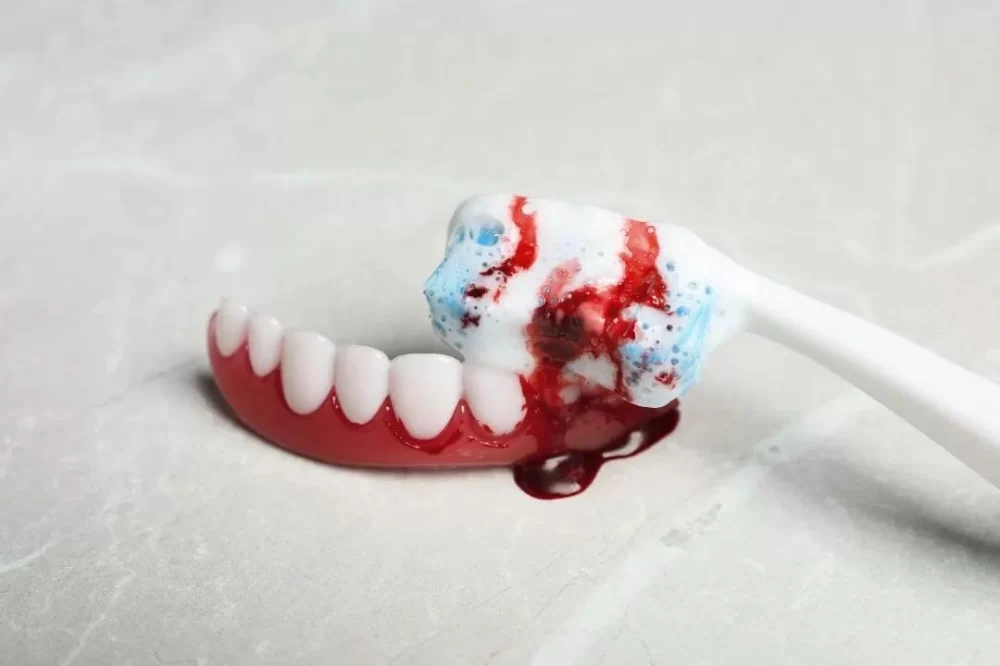
- Causes-of-Bleeding-Gums
- Treatment-Methods-for-Bleeding-Gums
- Preventing-Bleeding-Gums-in-the-Future
- Real-Life-Examples-and-Expert-Insights
1. Understanding What Causes Bleeding Gums From Brushing Too Hard
Bleeding gums are a common issue many people face, especially when brushing too hard. The delicate gum tissue can easily become irritated or damaged by aggressive brushing techniques. This leads to redness, tenderness, and bleeding during or after brushing. While it may seem like a sign to brush harder, it’s actually your body signaling that the gums need gentler care.
Overbrushing can cause the gums to recede, exposing more of the tooth root and increasing sensitivity. It also damages the protective gum lining, making it more vulnerable to bacterial infection. Besides brushing too hard, other factors like poor oral hygiene, vitamin deficiencies, or gum disease can contribute to bleeding gums. However, if the root cause is excessive brushing pressure, adjusting your technique is crucial to treatment and prevention.
For those struggling with bleeding gums caused by brushing too hard, it’s essential to recognize the early signs before permanent damage occurs. Sensitive gums that bleed intermittently during brushing or flossing are a clear warning sign that something needs to change.
2. Effective Ways to Treat Bleeding Gums Caused by Brushing Too Hard
Treating bleeding gums begins with addressing the brushing habits directly. Here are key steps to manage and heal gums affected by excessive brushing:
2.1 Switch to a Soft-Bristled Toothbrush
A toothbrush with soft bristles is gentle on the gums but still effective at cleaning teeth. Many dental professionals recommend using soft or extra-soft brushes to avoid further irritation. Electric toothbrushes with pressure sensors can also help regulate the force applied while brushing, preventing damage.
2.2 Correct Brushing Technique
Proper brushing involves using light pressure with short, gentle strokes at a 45-degree angle toward the gum line. Avoid scrubbing aggressively or using a horizontal back-and-forth motion, which tends to harm gum tissue. Spending at least two minutes brushing twice daily is sufficient when technique is correct.
2.3 Maintain Excellent Oral Hygiene
Bleeding gums can worsen if plaque and bacteria build up. Besides brushing carefully, floss daily to remove debris between teeth and consider using an antimicrobial mouthwash to reduce inflammation. Keeping the mouth clean helps gums heal faster.
2.4 Use Soothing Oral Products
Products containing natural anti-inflammatory ingredients like aloe vera, chamomile, or vitamin E can calm irritated gums. Avoid harsh toothpaste with sodium lauryl sulfate (SLS) or strong whitening agents while gums recover.
2.5 When to See a Dentist
If bleeding persists beyond two weeks despite gentle care, professional evaluation is necessary. Your dentist can check for underlying gum disease or other conditions requiring treatment. Early intervention improves outcomes and prevents complications.
3. How to Prevent Bleeding Gums From Occurring Again
Prevention is better than cure, especially when it comes to oral health. After healing your gums, maintaining the right habits is key to avoiding future bleeding. Consider the following:
3.1 Regular Dental Checkups
Scheduling dental visits every six months helps monitor gum health and detect early signs of problems. Professional cleanings remove hardened plaque (tartar) that brushing alone can’t handle.
3.2 Invest in Quality Oral Care Tools
Choose toothbrushes designed for sensitive gums and replace them every three months. Using interdental brushes or water flossers can also enhance cleaning without damaging gums.
3.3 Balanced Diet and Hydration
A nutritious diet rich in vitamin C and calcium supports gum tissue repair and strength. Staying hydrated helps maintain saliva flow, which naturally protects against bacterial growth.
3.4 Manage Stress and Avoid Tobacco
Stress and smoking negatively affect immune function and blood flow to gums, slowing healing and increasing bleeding risk. Quitting tobacco and managing stress contribute significantly to gum health.
4. Real-Life Examples and Professional Perspectives on Treating Bleeding Gums
Consider the story of Jessica, a 28-year-old who developed bleeding gums after switching to a hard-bristled toothbrush in an attempt to improve her oral hygiene. After consulting her dentist, she learned that her brushing technique was too aggressive, causing gum recession. By switching to a soft-bristled brush and using an electric toothbrush with a pressure sensor, her gums stopped bleeding within weeks. Jessica also adopted daily flossing and used a gentle mouthwash, which further accelerated healing.
This example highlights how simple changes can make a big difference. Dental experts emphasize that patients often worsen gum bleeding by misunderstanding its causes. Many assume brushing harder equals cleaner teeth, but the truth is quite the opposite. Dentistry Toothtruth offers a wide range of carefully selected oral care products and services to help users find the right tools for sensitive gums and effective gum care.
In summary, treating bleeding gums caused by brushing too hard involves gentle care, proper tools, and good habits. Understanding the underlying causes and acting promptly can restore gum health and prevent future issues. For anyone facing persistent gum bleeding or discomfort, consulting dental professionals and exploring recommended products on Dentistry Toothtruth can be the best step toward a healthier smile.







 Corona Family Dental Group3.0 (42 review)
Corona Family Dental Group3.0 (42 review) Genesis Dental of Taylorsville4.0 (842 review)
Genesis Dental of Taylorsville4.0 (842 review) Edmond Dental Center: Michael Chandler, DDS5.0 (404 review)
Edmond Dental Center: Michael Chandler, DDS5.0 (404 review) Cash Family Orthodontics4.0 (141 review)
Cash Family Orthodontics4.0 (141 review) Spring View Dental Care4.0 (1298 review)
Spring View Dental Care4.0 (1298 review) Acworth Smiles Dentistry4.0 (145 review)
Acworth Smiles Dentistry4.0 (145 review) The Importance of Oral Health Education During Pregnancy for a Healthy Pregnancy
The Importance of Oral Health Education During Pregnancy for a Healthy Pregnancy Best Tips for Brushing Your Teeth Properly for Healthy Gums: Essential Techniques for Oral Health
Best Tips for Brushing Your Teeth Properly for Healthy Gums: Essential Techniques for Oral Health Why Skipping Dental Checkups Can Lead to Bigger Oral Health Problems
Why Skipping Dental Checkups Can Lead to Bigger Oral Health Problems Advantages of Porcelain Dental Restorations
Advantages of Porcelain Dental Restorations How Can Diabetes Cause Tooth and Gum Problems? Preventing and Managing Oral Health Issues
How Can Diabetes Cause Tooth and Gum Problems? Preventing and Managing Oral Health Issues Healthy Habits for Promoting Good Oral Health and Hygiene: Tips for a Healthy Smile
Healthy Habits for Promoting Good Oral Health and Hygiene: Tips for a Healthy Smile